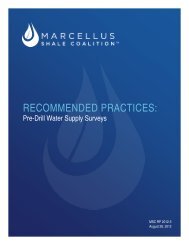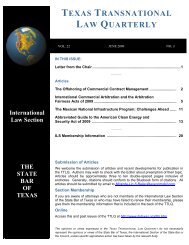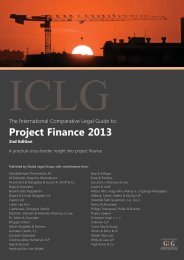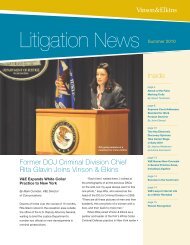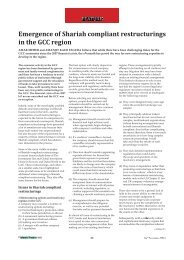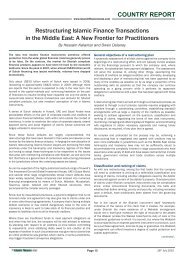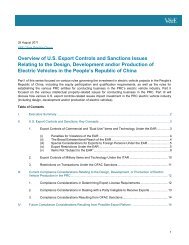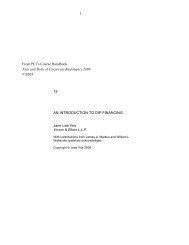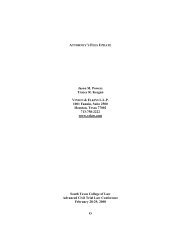Environmental News - Vinson & Elkins LLP
Environmental News - Vinson & Elkins LLP
Environmental News - Vinson & Elkins LLP
Create successful ePaper yourself
Turn your PDF publications into a flip-book with our unique Google optimized e-Paper software.
<strong>Environmental</strong> <strong>News</strong><br />
September 2007<br />
2<br />
Court Grants Summary Judgment to Citizen<br />
Suit Plaintiff Based on Credible Evidence of<br />
Opacity Violations<br />
3<br />
TCEQ Issues Long-Awaited Small MS4<br />
Stormwater Discharge General Permit<br />
5<br />
Greenhouse Gas Update: Massachusetts and<br />
Maine Issue Draft Regulations Implementing<br />
the Regional Greenhouse Gas Initiative; and<br />
Western Climate Initiative Issues Statement of<br />
Regional Goal<br />
8<br />
Radioactive Waste Regulation Transferred<br />
From TDSHS to TCEQ<br />
9<br />
TCEQ Regulatory Watch<br />
12<br />
Calendar of Events<br />
7<br />
Court Allows Natural Resource Trustees<br />
Prospective Recovery of Assessment Costs<br />
as Incurred on Hanford Nuclear Reservation<br />
V&E <strong>Environmental</strong> <strong>News</strong> is a monthly newsletter focusing on environmental regulatory and policy developments. It is published by the <strong>Environmental</strong><br />
and Administrative Law Section of <strong>Vinson</strong> & <strong>Elkins</strong> <strong>LLP</strong>. This newsletter is not intended to be legal advice or a legal opinion on any specific facts or<br />
circumstances. The contents are intended for general information purposes only. Application of the information reported herein to particular facts or<br />
circumstances should be analyzed by legal counsel.<br />
We welcome your comments and requests for subscriptions. V&E <strong>Environmental</strong> <strong>News</strong> is provided at no charge. Please report changes of contact<br />
information to Stephanie Schwausch 713.758.2131 sschwausch@velaw.com.<br />
© Copyright 2007 <strong>Vinson</strong> & <strong>Elkins</strong> <strong>LLP</strong>. All rights reserved. www.velaw.com
<strong>Environmental</strong> <strong>News</strong><br />
Court Grants Summary Judgment<br />
to Citizen Suit Plaintiff Based<br />
on Credible Evidence of<br />
Opacity Violations<br />
On August 27, 2007, a federal court in Alabama granted summary<br />
judgment to the Sierra Club in a citizen suit it brought<br />
against the Tennessee Valley Authority (TVA). The suit alleged<br />
thousands of violations of the 20 percent opacity standard at<br />
the TVA’s Colbert County, Alabama coal-fired power plant. The<br />
ruling by the Federal District Court for the Northern District of<br />
Alabama is notable, because it relied on continuous opacity<br />
monitoring system (COMS) data as “credible evidence” of the<br />
alleged violations, even though there were no violations<br />
demonstrated using the “authorized” method for measuring<br />
opacity (Method 9), and there was no evidence of any exceedence<br />
of the facility’s particulate matter (PM) emission limit.<br />
The credible evidence rule, as its name implies, allows<br />
any credible evidence of a violation to be used to demonstrate<br />
the existence of the violation. Previously, only “authorized”<br />
EPA monitoring techniques, such as Method 9, could be used<br />
to establish that a violation had occurred. The Sierra Club v.<br />
TVA opinion reportedly is the first instance following the adoption<br />
of the credible evidence rule that the rule has been used in<br />
a citizen suit against a power company.<br />
The underlying suit, which was filed in 2002, has had a<br />
complex procedural history. The motion for summary judgment<br />
decided on August 27 was urged following a 2005 appeal<br />
decided by the Eleventh Circuit. Among other things, the<br />
appeals court ruled that although Method 9 was the only<br />
method available to demonstrate an opacity violation until<br />
Alabama’s version of the “credible evidence” rule was approved<br />
by EPA, the credible evidence rule could be applied<br />
to any violation that occurred after that date. It held also that<br />
a particular provision of the Alabama air pollution rules, which<br />
authorizes a source to exceed its opacity limit for up to 2 percent<br />
of its operating hours each calendar quarter, was only an<br />
undocumented “interpretation” of the Alabama air rules during<br />
the relevant period; contravened the Clean Air Act’s mandate<br />
of continuous compliance; and had never been approved by<br />
EPA as part of Alabama’s state implementation plan.<br />
On remand, the Sierra Club moved for summary judgment<br />
on TVA’s liability for certain opacity exceedences measured by<br />
the COMS at the Colbert County plant that occurred between<br />
January 3, 2000 (the effective date of EPA’s approval of the<br />
Alabama credible evidence rule) and the cutoff date for the<br />
violations alleged in the Sierra Club’s complaint. The district<br />
court granted the motion in a lengthy opinion that addressed a<br />
number of arguments concerning the use of credible evidence<br />
to establish violations.<br />
Specifically, the court held that COMS data, by itself, is<br />
credible evidence of opacity violations, notwithstanding that the<br />
COMS readings could not be “correlated with” Method 9 opacity<br />
readings. As the court explained, “If COMS measurements<br />
have to be matched up to, correlated or related back to, or<br />
scientifically explained in terms of what a simultaneously taken<br />
Method 9 test would have shown, then the credible evidence<br />
rule is meaningless.” The court later went on to say that<br />
although it was not necessary to decide the motion for<br />
summary judgment:<br />
. . . even were TVA able to show at trial a series of Method<br />
9 tests performed contemporaneously with COMS readings,<br />
with the Method 9 readings under 20%, and the<br />
COMS over 20%, the court would not have to accept<br />
TVA’s technical or margin of error assertions. Advances in<br />
technology are not necessarily more accurate but, having<br />
received the voluminous filings and the declarations by<br />
various witnesses dealing with opacity testing methodology,<br />
the court finds that there is not a material factual<br />
dispute that COMS monitoring is, first, credible evidence,<br />
[and] second, a more accurate and reliable testing methodology<br />
[than Method 9] . . . .<br />
The court also held that the COMS data, by itself, was<br />
sufficient to find for the Sierra Club on a motion for summary<br />
judgment. For purposes of its summary judgment motion, the<br />
Sierra Club had agreed to drop its claims for opacity exceedences<br />
during “safe harbor” periods of startup, shutdown,<br />
and load change, and the TVA had agreed to waive any<br />
technical or permit defenses to opacity readings above 25<br />
percent. However, TVA apparently had argued that since<br />
Method 9 was accurate only to plus or minus 5 percent or<br />
since data collected more frequently than every six minutes<br />
might not show a violation, there were factual issues concerning<br />
whether any COMS readings between 20 and 25<br />
percent were actually evidence of violations. The court found<br />
that under the credible evidence rule, the COMS data showing<br />
opacity readings between 20 and 25 percent was sufficient<br />
evidence of a violation. Since there were no material factual<br />
disputes that the readings exceeded 20 percent, and since<br />
TVA’s COMS did not record data more frequently than every<br />
2
six minutes, there was sufficient evidence in the record to find<br />
TVA liable for these exceedences.<br />
TVA is exempt from civil penalties, because it is a federal<br />
agency, but it remains liable for injunctive relief. The court’s<br />
opinion addressed only the liability issues, so it remains to be<br />
seen what injunctive relief the court might find to be appropriate.<br />
The court expressed some sympathy to TVA for its result,<br />
since four of the Colbert facility’s units met the opacity standard<br />
99 percent of the time and the fifth met the opacity<br />
standard 99.5 percent of the time. But the court felt constrained<br />
by the 2005 appellate opinion and the credible evidence rule to<br />
find that TVA violated its opacity standard nearly 3,400 times<br />
between January 3, 2000 and September 26, 2002.<br />
That COMS data was found to be credible evidence is<br />
not surprising on its face, but the opinion is instructive because<br />
for all of the controversy surrounding the credible evidence<br />
rule, there have been few reported decisions that have addressed<br />
how the rule should be applied. This federal district<br />
court, at least, did not require any evidence using the prescribed<br />
compliance method, nor did it give much weight to<br />
attacks on the “credibility” of otherwise “credible evidence.” As<br />
a result, the owners of facilities with air emissions should be<br />
attentive to the implications of any data they may be generating<br />
that could be used to demonstrate a violation of an<br />
emission standard, even if authorized or other emission<br />
measurements demonstrate compliance.<br />
For more information about the Sierra Club v. TVA<br />
opinion or the credible evidence rule generally, please contact<br />
<strong>Vinson</strong> & <strong>Elkins</strong> lawyers Chris Amandes at 713.758.1146<br />
or Eric Groten at 512.542.8709.<br />
TCEQ Issues Long-Awaited Small<br />
MS4 Stormwater Discharge<br />
General Permit<br />
After an almost five-year wait, on August 13, 2007, TCEQ<br />
finally issued Texas Pollutant Discharge Elimination System<br />
(TPDES) General Permit TXR040000, which provides permit<br />
coverage for stormwater discharges associated with municipal<br />
separate storm sewer systems (MS4s) serving less than<br />
100,000 persons (small MS4s). These new regulations require<br />
regulated small MS4 operators to develop and implement a<br />
stormwater management program (SWMP) consisting of six<br />
comprehensive control measures designed to limit pollution<br />
discharged to surface waters in the state. Small MS4 operators<br />
that choose to obtain authorization under this general permit<br />
must submit a SWMP and a completed notice of intent (NOI)<br />
form to TCEQ on or before February 11, 2008.<br />
Background<br />
On September 14, 1998, TCEQ received authority from EPA to<br />
administer the TPDES program (which program includes the<br />
discharge of stormwater) as it relates to “surface waters in the<br />
State,” which term includes lakes, ponds, rivers, the Gulf of<br />
Mexico inside the territorial limits of the state, and all other<br />
bodies of surface water that are wholly or partially in Texas.<br />
On December 8, 1999, EPA published Phase II stormwater<br />
regulations that required regulated small MS4 operators to<br />
obtain permit coverage by March 10, 2003. These Phase II<br />
small MS4 regulations are in the federal rules at 40 C.F.R.<br />
Sections 122.30 through 122.37, which sections (other than<br />
the federal guidance in Sections 122.33 and 122.34) were<br />
adopted by reference as amended by TCEQ at 30 T.A.C.<br />
Section 281.25(b). Accordingly, TCEQ published notice of<br />
a proposed small MS4 general permit in the September 27,<br />
2002 issue of the Texas Register, with the original comment<br />
period ending on November 15, 2002. However, on<br />
September 15, 2003, the U.S. 9th Circuit Court of Appeals<br />
(Court), in <strong>Environmental</strong> Defense Center v. EPA, 344 F.3d<br />
832 (9th Cir., 2003) issued a revised panel decision that<br />
remanded portions of the federal Phase II rules affecting<br />
small MS4s to EPA. The Court found that portions of the<br />
federal regulations were not consistent with the federal Clean<br />
Water Act because the Phase II rules did not, among other<br />
things, address public participation in the permitting process,<br />
namely, not allowing the public to comment on NOIs submitted<br />
by applicants seeking permit coverage under the general permit.<br />
EPA responded by issuing a memorandum dated April 16,<br />
2004 in which EPA provided guidance for permitting authorities,<br />
such as TCEQ, on how to issue general permits consistent<br />
with the Court’s decision. TCEQ revised the proposed<br />
general permit in accordance with EPA memorandum and<br />
published notice of the revised proposed general permit on<br />
August 26, 2005. A public meeting on the revised proposed<br />
permit was held in Austin on September 29, 2005, and the<br />
comment period for the revised permit ended at the close of<br />
the public meeting.<br />
Who Is Eligible to Apply for Small MS4 General<br />
Permit Coverage?<br />
Stormwater permitting programs already exist for large MS4s<br />
(serving 250,000 or more persons) and medium MS4s (serving<br />
3
<strong>Environmental</strong> <strong>News</strong><br />
100,000 or more, but less than 250,000 persons) pursuant to<br />
the Phase I NPDES stormwater regulations adopted by EPA in<br />
the early 1990s. Small MS4s are considered Phase II sources<br />
and mean any MS4 not already covered under Phase I of the<br />
NPDES stormwater program, including specifically those MS4s<br />
serving populations of less than 100,000 in urbanized areas.<br />
Under the Phase II rules, small MS4 operators that are fully or<br />
partially located within an urbanized area (UAs) as determined<br />
by the 2000 Decennial Census conducted by the U.S. Bureau<br />
of Census must obtain authorization for their stormwater<br />
discharge runoff. Permit coverage is intended to be provided<br />
primarily under the small MS4 general permit. While permit<br />
coverage also is available under an individual stormwater<br />
permit, such coverage is generally undesirable, given the<br />
likely time delays and amounts of information that would be<br />
required in order to process such a permit. A map detailing<br />
UAs located in Texas is available at http://cfpub.epa.gov/<br />
npdes/stormwater/urbanmapresult.cfm?state=TX.<br />
In addition, TCEQ has the authority to designate small<br />
MS4 operators who are outside an urbanized area as being<br />
subject to regulation. This designation may be made by TCEQ<br />
on a case-by-case basis only after it conducts an evaluative<br />
process using certain enumerated factors, which determines<br />
that controls are necessary to protect water quality. MS4<br />
operators designated as being subject to regulation will be<br />
notified in writing by TCEQ and must seek coverage under the<br />
MS4 general permit or, alternatively, an individual permit.<br />
Submitting an NOI and Providing Public Notice<br />
Small MS4 operators subject to regulation who are seeking<br />
coverage under the small MS4 general permit are required to<br />
submit a completed NOI and a SWMP by February 11, 2008.<br />
Operators of small MS4s who are subsequently designated by<br />
TCEQ to be subject to regulation are required to submit the<br />
NOI and SWMP within 180 days of being notified in writing by<br />
TCEQ of the need to obtain permit coverage.<br />
In addition, as a result of the <strong>Environmental</strong> Defense<br />
Center v. EPA court decision, after submittal of the NOI and<br />
SWMP and upon receipt of written instructions from TCEQ,<br />
the applicant is now required to publish notice of the executive<br />
director’s preliminary determination on the NOI and SWMP in<br />
the newspaper. The notice must provide opportunity for the<br />
public to submit comments on the NOI and SWMP, which<br />
comment period will remain open for a period of 30 days from<br />
the first date the notice is published. In addition, the notice<br />
must allow the public to request a public meeting. A public<br />
meeting will be held if TCEQ determines that there is<br />
significant public interest.<br />
Discharge authorization begins when the applicant is<br />
notified by TCEQ that the NOI and the SWMP have been<br />
administratively and technically reviewed and the applicant<br />
has followed the applicable public participation provisions. In<br />
the event an NOI and SWMP are not submitted until after the<br />
February 11, 2008 deadline, authorization by TCEQ will be<br />
granted only for discharges that occur after permit coverage<br />
is finally obtained. TCEQ reserves the right to take appropriate<br />
enforcement actions for any unpermitted discharges.<br />
An application fee of $100 must be submitted with each<br />
NOI. Moreover, a permittee authorized under the small MS4<br />
general permit must pay an annual Water Quality fee of $100<br />
pursuant to Texas Water Code Section 26.0291 and 30 T.A.C.<br />
Chapter 205.<br />
SWMP Is Required<br />
A critical part of complying with the small MS4 general permit<br />
is the development and implementation of a SWMP, which<br />
plan is intended to prevent pollution in stormwater to the<br />
“maximum extent practicable.” To satisfy this standard, TCEQ<br />
requires regulated small MS4 operators to develop and implement,<br />
at a minimum, six different programs designed to help in<br />
preventing stormwater pollution. These programs, which will<br />
require extensive participation by, and support of, the regulated<br />
MS4 operators, address:<br />
• public education and outreach on stormwater impacts;<br />
• public participation and involvement in the stormwater<br />
management program development and implementation;<br />
• illicit discharges detection and elimination;<br />
• construction site storm sewer runoff control;<br />
• post-construction stormwater management in new<br />
development and redevelopment activities; and<br />
• pollution prevention and good housekeeping for<br />
municipal operations.<br />
Regulated MS4 operators will be required to submit<br />
schedules describing the deadlines by which these programs<br />
will be implemented over the life of the general permit. The<br />
programs must be completely implemented by the expiration<br />
date of the small MS4 general permit, which is five years after<br />
its issuance (or within five years of a small MS4 operator being<br />
designated as being subject to regulation). Implementation of<br />
the SWMP is required to commence immediately following<br />
receipt of written authorization from TCEQ.<br />
4
As part of its implementation of these six measures,<br />
regulated small MS4 operators also will be required to develop<br />
a map of their storm sewer system. This map must include the<br />
location of all outfalls, the names and locations of all waters of<br />
the United States that receive discharges from the outfalls,<br />
and any additional information needed by the permittee to<br />
implement its SWMP.<br />
Waivers From Regulation Under the Small MS4<br />
General Permit Exist<br />
Certain operators of small MS4 systems may avoid regulation<br />
by means of a waiver authorized by TCEQ. Two forms of<br />
waivers exist. Under Waiver Option 1, an operator of an otherwise<br />
regulated small MS4 may be excused from performance if<br />
the MS4 meets all of the following conditions:<br />
• MS4 serves a population of less than 1,000 within an UA;<br />
• MS4 does not contribute substantially to the pollutant<br />
loadings of a regulated, physically interconnected MS4<br />
(whether small, medium, or large); or<br />
• if MS4 discharges any pollutant that has been identified as<br />
a cause of impairment to any water body to which the MS4<br />
discharges, stormwater controls are not needed based on<br />
the waste load allocation that is part of any EPA-approved<br />
or established total maximum daily load (TMDL) for that<br />
pollutant.<br />
By comparison, under Waiver Option 2, an operator of an<br />
otherwise regulated small MS4 may be excused from performance<br />
if the MS4 meets all of the following conditions:<br />
• the MS4 serves a population of less than 10,000;<br />
• TCEQ has evaluated all waters of the United States and<br />
has determined that stormwater controls are not needed<br />
for any pollutant of concern based on the TMDL or, if the<br />
TMDL has not been developed or approved, an equivalent<br />
analysis that determines sources and allocations for the<br />
pollutant of concern; or<br />
• TCEQ has determined that future discharges from the<br />
MS4 do not have the potential to exceed Texas surface<br />
water quality standards or cause other significant water<br />
quality impacts.<br />
If a small MS4 operator is eligible for a waiver under<br />
Waiver Option 1, then the operator must complete and submit<br />
a waiver certification form. Small MS4 operators seeking to be<br />
excused from performance under Waiver Option 2 must contact<br />
TCEQ to request a waiver. The waiver exclusion process<br />
under Waiver Option 2 will require a comprehensive evaluation<br />
of all receiving water bodies and, according to TCEQ, “may be<br />
difficult to obtain.”<br />
Small MS4 General Permit Workshops Are<br />
Being Sponsored by TCEQ<br />
TCEQ is currently offering workshops on the newly adopted<br />
small MS4 general permit. The workshops will present information<br />
on the general permit and application process as well<br />
as discussion on components of the SWMP. Seating is expected<br />
to be limited and thus interested parties should contact<br />
TCEQ at 210.403.4092 to reserve a seat. Two separate workshops<br />
will be held in Houston on November 6, 2007 at the<br />
Johnson Space Center: 8:30 a.m. to 12:00 p.m. and 1:00 to<br />
4:30 p.m. For a complete schedule, visit the TCEQ website.<br />
As stated above, the deadline for submitting an NOI and<br />
SWMP is February 11, 2008. It is imperative that small MS4<br />
operators begin planning now in order to meet this deadline.<br />
If you have any questions regarding the Small MS4 General<br />
Permit or on stormwater permitting in general, please call<br />
<strong>Vinson</strong> & <strong>Elkins</strong> lawyer Larry Pechacek at 713.758.2004.<br />
Greenhouse Gas Update:<br />
Massachusetts and Maine Issue<br />
Draft Regulations Implementing the<br />
Regional Greenhouse Gas Initiative;<br />
and Western Climate Initiative Issues<br />
Statement of Regional Goal<br />
As summer came to a close, several more developments took<br />
place with regard to the emerging body of state and regional<br />
greenhouse gas (GHG) regulatory initiatives. Massachusetts<br />
and Maine issued draft regulations implementing the Regional<br />
Greenhouse Gas Initiative (RGGI) and the Western Climate<br />
Initiative issued a statement of regional goal. As reported in the<br />
July and August 2007 issues of V&E <strong>Environmental</strong> <strong>News</strong>,<br />
there is a growing list of states, mostly on the east and west<br />
coasts, that have decided not to wait on federal GHG legislation<br />
but rather to pursue their own regulatory initiatives to<br />
control GHG. These state initiatives are viewed as possible<br />
models for future federal GHG legislation.<br />
5
<strong>Environmental</strong> <strong>News</strong><br />
Massachusetts and Maine Issue Draft<br />
Regulations to Implement Cap-and-Trade<br />
Program under RGGI<br />
Apart from the pre-proposal draft regulations published in<br />
New York last December, the Massachusetts and Maine draft<br />
regulations are among the first regulatory cap-and-trade<br />
proposals to be published for comment in any of the RGGI<br />
member states, bringing them closer towards the implementation<br />
of the first mandatory GHG control regime in<br />
the United States. RGGI is an effort among Connecticut,<br />
Delaware, Maine, Maryland, Massachusetts, New Hampshire,<br />
New Jersey, New York, Rhode Island, and Vermont to develop<br />
a regional carbon dioxide cap-and trade program that first<br />
stabilizes and then reduces carbon dioxide emissions from<br />
fossil-fuel-fired power plants, with the goal of reducing the<br />
2018 annual emissions budget to 10 percent less than the<br />
initial 2009 emissions budget. The RGGI members have<br />
agreed to a Memorandum of Understanding (MOU) and<br />
agreed upon a model rule to implement the cap-and-tradeprogram.<br />
The Massachusetts and Maine proposed regulations<br />
follow the model rule with some variation.<br />
The Massachusetts draft regulations, issued under<br />
existing legislation authorizing the Massachusetts Department<br />
of <strong>Environmental</strong> Protection (MassDEP) to regulate air emissions,<br />
will regulate carbon dioxide emissions from fossil-fuelfired<br />
power plants with a capacity of 25 megawatts or more<br />
effective January 1, 2009. For units in operation prior to<br />
January 1, 2005, only those where fossil fuel compromises<br />
more than 50 percent of total heat input will be subject to<br />
the rules, whereas for units starting operation on or after<br />
January 1, 2005, all units using fossil fuels for more than<br />
5 percent of total heat input will be subject to the rules.<br />
MassDEP reports that there are 32 sources classified as<br />
fossil-fuel-fired units that would be regulated under these rules.<br />
Massachuetts did not adopt the optional provision in the model<br />
rule that would exempt units that sell less than 10 percent of<br />
their net generating capacity.<br />
To stabilize and then reduce carbon dioxide emissions,<br />
the Massachusetts proposed regulations adopt the state carbon<br />
dioxide budget provided in the MOU, establishing a cap<br />
through 2014 and then cutting carbon dioxide emissions by 2.5<br />
percent per year. Massachusetts proposes to allocate its carbon<br />
dioxide allowances by auctioning 100 percent of them in a<br />
regional or statewide auction. This provision is likely to cause<br />
debate, as auctioning all the allowances may be viewed by<br />
some as likely to increase energy costs. Massachusetts<br />
responded to such concerns by indicating that it intends to use<br />
the auction proceeds, an estimated $25 million to $125 million<br />
per year, to fund energy efficiency, peak demand reduction,<br />
and other cost-cutting efforts.<br />
Massachusetts proposes to adopt offset provisions based<br />
on the model rule, providing carbon dioxide allowances to<br />
projects that represent carbon dioxide equivalent emission<br />
reductions or carbon sequestration that are real, additional,<br />
verifiable, enforceable, and permanent. Consistent with the<br />
model rule, Massachusetts’ proposed regulations would<br />
impose a cap on the number of offset allowances used by a<br />
power plant, allowing an affected power plant to cover only up<br />
to 3.3 percent of its reported emissions with offset allowances.<br />
Thus, a significant portion of the required carbon dioxide emission<br />
reductions must occur at the power plants and cannot be<br />
offset through other projects.<br />
However, only projects located in a RGGI participating<br />
state or in a state that has a cooperative agreement with<br />
Massachusetts will be eligible for offset credit. The draft regulations<br />
require that non-RGGI governmental authorities complete<br />
cooperative agreements with all RGGI participating states in<br />
order to be eligible as offset allowances in Massachusetts.<br />
The draft regulations also prevent smaller projects outside the<br />
RGGI region from being eligible for offset credit by requiring<br />
that projects outside of RGGI states exceed a minimum<br />
threshold of 20,000 tons of annual reduction carbon dioxide.<br />
The proposed regulations list five types of approved<br />
offset projects: (1) landfill methane capture and destruction;<br />
(2) reduction in emissions of sulfur hexafluoride; (3) sequestration<br />
of carbon due to afforestation; (4) reduction or avoidance<br />
of carbon dioxide emissions from natural gas, oil, or propane<br />
end-use combustion due to end-use energy efficiency; and<br />
(5) avoided methane emissions from agricultural manure<br />
management operations.<br />
The proposed regulations do contain price triggers if<br />
the costs of allowances are higher than expected. If the 12-<br />
month average price of a carbon dioxide allowance equals<br />
or exceeds $7.00 (in 2005 dollars), affected units will be<br />
allowed to increase their use of offsets from 3.3 percent to 5<br />
percent of their compliance obligation. If the 12-month average<br />
price of a carbon dioxide allowance equals or exceeds $10.00<br />
(in 2005 dollars), affected units will be allowed to expand their<br />
use of carbon dioxide offset credits to 10 percent of their<br />
compliance obligation.<br />
Maine’s proposed regulation generally parallels<br />
Massachusetts’ proposal with several limited exceptions.<br />
6
Unlike Massachusetts, Maine’s regulation will only become<br />
effective January 1, 2009 if the other states whose electrical<br />
utilities are administered by the same regional transmission<br />
organization as Maine have implemented similar cap-and-trade<br />
programs and the combined carbon dioxide emissions budget<br />
from those states is at least 35 million tons per year. Maine’s<br />
regulation also exempts plants that supply no more than 10<br />
percent of their electricity to a transmission and distribution<br />
utility annually as permitted by the model rule, unlike the<br />
Massachusetts regulation.<br />
Western Climate Initiative Issues Statement of<br />
Regional Goal<br />
On August 22, 2007, the six states and two Canadian<br />
provinces that make up the Western Climate Initiative (WCI)<br />
issued a GHG Reduction Goal statement in which they agreed<br />
to collectively cut greenhouse gas emissions to 15 percent<br />
below 2005 levels by 2020. The WCI consists of Arizona,<br />
California, New Mexico, Oregon, Utah, Washington, British<br />
Columbia, and Manitoba, and was created in February 2007 to<br />
implement a joint strategy to reduce greenhouse gas emissions.<br />
WCI partners were directed to develop a regional target<br />
for reducing greenhouse gases, to develop a market-based<br />
program to reach the target, and to participate in a multi-state<br />
registry to track and manage greenhouse gas emissions in<br />
their region. This regional goal is an aggregation of the goals<br />
all eight WCI partners established individually, but it does not<br />
replace the individual goals. By August 2008, the WCI will<br />
complete the design of a market-based mechanism to achieve<br />
this reduction goal.<br />
In addition to setting the regional GHG reduction goal, the<br />
statement sets forth standards for new entrants into the WCI,<br />
suggested emission reduction activities, and reporting requirements<br />
to the other WCI partners on their “climate action plan”<br />
and GHG emission inventories every two years.<br />
For more information on greenhouse gas regulation<br />
contact <strong>Vinson</strong> & <strong>Elkins</strong> lawyers Larry Nettles at<br />
713.758.4586 or Jessica Held at 202.639.6636.<br />
Court Allows Natural Resource<br />
Trustees Prospective Recovery of<br />
Assessment Costs as Incurred on<br />
Hanford Nuclear Reservation<br />
A federal district court in Washington State recently shook the<br />
landscape of Natural Resource Damages (NRD) litigation by<br />
issuing a declaratory order allowing trustees to recover assessment<br />
costs upon a showing of liability of one responsible party.<br />
In so ruling, the decision in Confederated Tribes & Bands of<br />
the Yakama Nation v. United States, No. CY-02-3105.LRS,<br />
2007 WL 2570437 (E.D. Wash. Sept. 4, 2007), became the<br />
first to grant natural resource trustees prospective relief under<br />
the Comprehensive <strong>Environmental</strong> Response, Compensation<br />
and Liability Act (CERCLA).<br />
Since CERCLA’s inception, the enormous up-front costs<br />
of performing injury assessments to prove damages — often in<br />
the millions of dollars — have in part kept the number of NRD<br />
cases few and far between. The district court in Confederated<br />
Tribes opens the door to prospective recovery of assessment<br />
costs by differentiating “costs” from “damages” under<br />
CERCLA, thereby placing assessment costs outside the<br />
strict limitations statute of CERCLA. According to the court,<br />
“costs” reimburse a party for certain expenses incurred (i.e.,<br />
reimbursement for a damage assessment), whereas “damages”<br />
are intended to compensate for the actual injury or loss<br />
revealed by an assessment. By so differentiating, the court<br />
ruled that natural resource trustees can recover assessment<br />
costs already incurred, as well as additional costs, so long as<br />
“reasonable” to the court.<br />
The implications of this recent decision remain unclear.<br />
Although Confederated Tribes certainly marks a victory for<br />
NRD trustees, proof of liability will continue to be a significant<br />
hurdle in this controversial area of law. Nonetheless, by allowing<br />
natural resource trustees to recover their assessment costs<br />
independently from their claims for damages, the Confederated<br />
Tribes decision potentially reduces a major impediment to NRD<br />
litigation. If later courts expound upon this decision by shifting<br />
the significant costs of performing cost damage assessment to<br />
defending parties at a pre-liability stage, or if courts mandate<br />
that adverse parties share costs at the outset of litigation, the<br />
NRD landscape could be dramatically altered.<br />
If you have any questions regarding the potential<br />
implications of this federal district court decision, please<br />
7
<strong>Environmental</strong> <strong>News</strong><br />
contact <strong>Vinson</strong> & <strong>Elkins</strong> lawyers Sharon Mattox at<br />
713.758.4598 or Taylor Pullins at 713.758.3432.<br />
Radioactive Waste Regulation<br />
Transferred From TDSHS to TCEQ<br />
TCEQ has proposed changes to the rules that regulate<br />
radioactive waste www.tceq.state.tx.us/rules/prop.html. The<br />
rulemaking implements Senate Bill (SB) 1604 from the 80th<br />
Legislative Session www.legis.state.tx.us/tlodocs/80R/billtext/<br />
pdf/SB01604F.pdf. SB 1604 mandates the transfer of<br />
regulatory and licensing responsibilities for uranium mining, byproduct<br />
disposal, and commercial radioactive substance processing<br />
from the Texas Department of State Health Services<br />
(TDSHS) to TCEQ. Currently, TDSHS regulates these activities,<br />
while TCEQ regulates other radioactive waste disposal,<br />
including disposal of low-level radioactive waste. SB 1604<br />
consolidates the regulatory jurisdiction of all these activities<br />
under TCEQ. Personnel from TDSHS have already relocated<br />
to TCEQ.<br />
Members of the regulated community impacted by the<br />
changes are radioactive waste storage and processing industries,<br />
uranium miners, and by-product disposal facilities. TCEQ<br />
has emphasized that the proposed changes should not impose<br />
new regulatory requirements on businesses or individuals or<br />
increase fiscal obligations for currently regulated businesses or<br />
individuals. Rather, the TCEQ’s rulemaking is intended simply<br />
to transfer regulation from TDSHS to TCEQ.<br />
In addition to the ministerial transfer of functions,<br />
contested hearings over license applications now will be held<br />
under TCEQ, not TDSHS, rules. The practical impact of this<br />
change is that TCEQ’s definition of “affected person” (30 TAC<br />
§ 55.3) is broader than TDSHS’s (25 TAC § 289.205) and thus<br />
will offer more opportunities for challenging such applications.<br />
The rulemaking alters four chapters of Title 30 of the<br />
Texas Administrative Code: (1) Chapter 37, financial<br />
assurance; (2) Chapter 39, public notice; (3) Chapter 281,<br />
applications processing; and (4) Chapter 336, radioactive<br />
substance rules. A public hearing regarding this rulemaking<br />
will be held in Austin on September 25, 2007. Public comments<br />
are being solicited through October 8, 2007. The anticipated<br />
adoption date for the rules is December 19, 2007.<br />
SB 1604 also amends the TCEQ’s underground<br />
injection control program for regulation of uranium mining<br />
and requires TCEQ to establish a new state fee for the<br />
disposal of radioactive waste. TCEQ does not address these<br />
statutory changes in this rulemaking but instead will develop a<br />
separate, future rulemaking. TCEQ also may take a fresh look<br />
at the by-product disposal rules within the next year.<br />
For more information on TCEQ radioactive<br />
waste rulemaking, contact <strong>Vinson</strong> & <strong>Elkins</strong> lawyers<br />
Lewis Sutherland at 713.758.2367 or Mary Conner<br />
at 713.758.3365.<br />
8
TCEQ Regulatory Watch<br />
Air Rules<br />
The following significant new air rule adoption has been<br />
published since the August 2007 issue of the V&E<br />
<strong>Environmental</strong> <strong>News</strong>.<br />
New Proposed Rules<br />
General Air Quality Rules<br />
• 32 Tex. Reg. 5296 – August 24, 2007<br />
• 30 TAC Chapter 113<br />
• TCEQ proposes amendments to certain sections of<br />
Chapter 113. The proposed amendments to Chapter 113<br />
would incorporate amendments that EPA made to the<br />
National Emission Standards for Hazardous Air Pollutants<br />
(NESHAP) for Source Categories, under 40 Code of<br />
Federal Regulations (CFR) Part 63 and add six NESHAPs<br />
that have not previously been incorporated into Chapter<br />
113. The proposed amendments would incorporate by<br />
reference amendments that EPA made to NESHAP for<br />
Source Categories under 40 CFR Part 63. These are<br />
technology-based standards commonly referred to as<br />
the maximum achievable control technology (MACT)<br />
standards. The MACT standards are required by the<br />
Federal Clean Air Act Amendments of 1990 (FCAA),<br />
Section 112, which requires EPA to develop national<br />
technology-based standards for new and existing sources<br />
of hazardous air pollutants listed in Section 112. The<br />
MACT standards are generally required to be based<br />
on the maximum degree of emission control that is<br />
achievable, taking into consideration cost and any nonair<br />
quality health and environmental impacts and energy<br />
requirements. In addition, the proposed new sections<br />
would incorporate by reference six MACT standards that<br />
have not been previously incorporated into Chapter 113.<br />
EPA is developing these national standards to regulate<br />
emissions of hazardous air pollutants as required under<br />
FCAA, Section 112, as codified in 42 United States Code,<br />
Section 7412.<br />
• Comments due by: September 24, 2007<br />
• Need additional information? Please contact <strong>Vinson</strong> &<br />
<strong>Elkins</strong> lawyer Chris Amandes at 713.758.1146.<br />
Control of Air Pollution From Motor Vehicles<br />
• 32 Tex. Reg. 5315 – August 24, 2007<br />
• 30 TAC Chapter 114<br />
• TCEQ proposes amendments to Sections 114.7, 114.62,<br />
114.64, 114.66, and 114.70. The Commission proposes<br />
these revisions in order to implement requirements of<br />
Senate Bill (SB) 12, authored by the Honorable Senator<br />
Averitt, passed during the 80th Legislature, 2007. During<br />
the 77th Legislature, 2001, the legislature adopted<br />
provisions, House Bill (HB) 2134, to assist low-income<br />
individuals with repairs, retrofits, or retirement of vehicles<br />
that fail emissions inspections. As required by HB 2134,<br />
the Commission adopted rules providing the minimum<br />
guidelines for counties to implement a low income vehicle<br />
repair assistance, retrofit, and accelerated vehicle retirement<br />
program (LIRAP).<br />
• Comments due by: September 12, 2007<br />
• Need additional information? Please contact <strong>Vinson</strong> &<br />
<strong>Elkins</strong> lawyer Larry Nettles at 713.758.4586.<br />
Control of Air Pollution by Permits for New Construction<br />
or Modification<br />
• 32 Tex. Reg. 6053 – September 7, 2007<br />
• 30 TAC Chapter 116<br />
• TCEQ proposes amendments to Section 116.114. The<br />
proposed rule amendment is required by House Bill (HB)<br />
3732, passed by the 80th Legislature, Regular Session,<br />
which sets the deadlines and directed TCEQ to adopt corresponding<br />
rules no later than January 1, 2008. The intent<br />
of HB 3732 and the associated rules is to provide an<br />
incentive to encourage the development of certain types<br />
of electric power projects that meet stringent emission<br />
limits. The proposed rule amendment would establish<br />
deadlines for the Agency's review of air permit applications<br />
for Advanced Clean Energy Projects (ACEP), in order to<br />
ensure that those permits are issued in an expedited manner.<br />
The rule proposal would require that the executive<br />
director complete the technical review of an ACEP permit<br />
application within nine months of determining the application<br />
is administratively complete. The rule proposal also<br />
requires the Commission to issue a final order issuing or<br />
denying the permit within nine months of the date the<br />
executive director determines the application is technically<br />
complete. The Commission has discretion to extend this<br />
deadline by up to three months, if meeting the deadline<br />
would create an extraordinary burden on Commission<br />
resources. The Commission specifically invites comment<br />
on whether or not the executive director should directly<br />
refer all ACEP air permit applications to the State Office of<br />
9
TCEQ Regulatory Watch<br />
Administrative Hearings in order to ensure that hearings<br />
and permit issuance or denial can be completed within the<br />
deadlines specified in Texas Health and Safety Code<br />
(THSC), Section 382.0566.<br />
• Comments due by: September 26, 2007<br />
• Need additional information? Please contact <strong>Vinson</strong> &<br />
<strong>Elkins</strong> lawyer Kristie Tice at 713.758.3653.<br />
Water Quality Rules<br />
The following significant new water quality rule adoption has<br />
been published since the August 2007 issue of the V&E<br />
<strong>Environmental</strong> <strong>News</strong>.<br />
New Proposed Rules<br />
Water Conservation Plans, Drought Contingency Plans,<br />
Guidelines and Requirements Water Conservation Plans,<br />
Drought Contingency Plans, Guidelines and Requirements<br />
• 32 Tex. Reg. 6060 – September 7, 2007<br />
• 30 TAC Chapter 288<br />
• TCEQ proposes to amend Sections 288.1 and 288.30.<br />
The proposed rules implement the sections of Senate Bill<br />
(SB) 3 and House Bill (HB) 4, both of which were passed<br />
in the 80th Legislature, dealing with water conservation<br />
planning. These sections, as implemented by the proposed<br />
rules, would amend the Texas Water Code (TWC)<br />
and: mandate the Agency to require a retail public utility<br />
providing potable water service to 3,300 or more connections<br />
to submit a water conservation plan and annual<br />
progress reports to the executive administrator of the<br />
Texas Water Development Board; require any entity<br />
currently required to submit a water conservation plan<br />
to the Agency under other provisions of the TWC to also<br />
submit a copy of the plan to the executive administrator of<br />
the Board; and require all entities with water conservation<br />
plans to submit an annual progress report regarding water<br />
conservation plan implementation to the executive administrator<br />
of the Board. The Board must review these plans<br />
and annual reports to determine if they comply with minimum<br />
requirements. The Agency and the Board are<br />
required by the legislation and proposed rule to identify<br />
minimum requirements for water conservation plans,<br />
deadlines for annual report submission, and provide for<br />
enforcement of the proposed rules.<br />
• Comments due by: October 9, 2007<br />
• Need additional information? Please contact <strong>Vinson</strong> &<br />
<strong>Elkins</strong> lawyer Sharon Mattox at 713.758.4598.<br />
Waste Rules<br />
The following significant new waste rule adoptions have been<br />
published since the August 2007 issue of the V&E<br />
<strong>Environmental</strong> <strong>News</strong>.<br />
New Proposed Rules<br />
Financial Assurance<br />
• 32 Tex. Reg. 6045 – September 7, 2007<br />
• 30 TAC Chapter 37<br />
• TCEQ proposes amendments to Sections 37.9001,<br />
37.9030, 37.9035, 37.9040, and 37.9045. The changes<br />
proposed to this chapter are part of a larger proposal to<br />
revise the Commission's radiation control rules. The<br />
primary purpose of the proposed rules is to implement<br />
Senate Bill (SB) 1604, 80th Legislature, 2007, and its<br />
amendments to THSC, Chapter 401 (also known as the<br />
Texas Radiation Control Act (TRCA)). The bill transfers<br />
responsibilities for the regulation and licensing of source<br />
material recovery, by-product disposal, and commercial<br />
radioactive substances storage and processing from the<br />
Texas Department of State Health Services (TDSHS) to<br />
the Commission. This proposed rulemaking intends to<br />
transfer the technical requirements for these programs<br />
from the TDSHS's rules Sections 289.254 and 289.260<br />
of 25 TAC into new subchapters of the Commission's<br />
radioactive substantive rules in Chapter 336. While the<br />
technical requirements remain the same, these new<br />
Commission programs will be integrated into and administered<br />
under the Commission's existing radioactive<br />
material program requirements for application processing,<br />
public notice, public participation, licensing fees, financial<br />
assurance, and enforcement. The proposed amendments<br />
to Chapter 37 establish the financial assurance requirements<br />
for licenses for uranium recovery, by-product<br />
disposal, and radioactive substances storage and processing.<br />
The Commission proposes that the existing<br />
financial assurance requirements of Subchapter T of<br />
Chapter 37 be used for the licensing programs subject<br />
to the transfer of jurisdiction in SB 1604. SB 1604 also<br />
establishes a new state fee for disposal of radioactive<br />
substances and amends underground injection control<br />
10
TCEQ Regulatory Watch<br />
requirements for uranium mining. The Commission intends<br />
to address the new requirements in separate rulemaking<br />
actions.<br />
• Comments due by: October 7, 2007<br />
• Need additional information? Please contact <strong>Vinson</strong> &<br />
<strong>Elkins</strong> lawyer Mary Conner at 713.758.3365.<br />
Public Notice<br />
• 32 Tex. Reg. 6049 – September 7, 2007<br />
• 30 TAC Chapter 39<br />
• TCEQ proposes amendments to Sections 39.702, 39.703,<br />
39.707, and 39.709. The changes proposed to this chapter<br />
are part of a larger proposal to revise the Commission's<br />
radiation control rules. The primary purpose of the proposed<br />
rules is to implement SB 1604, 80th Legislature,<br />
2007, and its amendments to THSC, Chapter 401 (also<br />
known as TRCA). The bill transfers responsibilities for the<br />
regulation and licensing of source material recovery, byproduct<br />
disposal, and commercial radioactive substances<br />
storage and processing from the TDSHS to the Commission.<br />
This proposed rulemaking intends to transfer<br />
the technical requirements for these programs from the<br />
TDSHS' rules in Sections 289.254 and 289.260 of 25 TAC<br />
into new subchapters of the Commission's radioactive<br />
substantive rules in Chapter 336. While the technical<br />
requirements remain the same, these new Commission<br />
programs will be integrated into and administered under<br />
the Commission's existing radioactive material program<br />
requirements for application processing, public notice,<br />
public participation, licensing fees, financial assurance,<br />
and enforcement. The proposed amendments to Chapter<br />
39, Subchapter M establish the public notice requirements<br />
for radioactive materials licenses issued under Chapter<br />
336. SB 1604 also establishes a new state fee for disposal<br />
of radioactive substances and amends underground<br />
injecttion control requirements for uranium mining. The<br />
Commission intends to address the new requirements in<br />
separate rulemaking actions.<br />
• Comments due by: October 7, 2007<br />
Need additional information? Please contact <strong>Vinson</strong> & <strong>Elkins</strong><br />
lawyer Mary Conner at 713.758.3365.<br />
Applications Processing<br />
• 32 Tex. Reg. 6056 – September 7, 2007<br />
• 30 TAC Chapter 281<br />
• TCEQ proposes amendments to Section 281.19. The<br />
changes proposed to this chapter are part of a larger<br />
proposal to revise the Commission's radiation control<br />
rules. The primary purpose of the proposed rule is to<br />
implement SB 1604, 80th Legislature, 2007, and its<br />
amendments to THSC, Chapter 401 (also known as the<br />
TRCA). The bill transfers responsibilities for the regulation<br />
and licensing of source material recovery, by-product<br />
disposal, and commercial radioactive substances storage<br />
and processing from TDSHS to the Commission. This<br />
proposed rulemaking intends to transfer the technical<br />
requirements for these programs from the TDSHS’ rules<br />
in Sections 289.254 and 289.260 of 25 TAC into new<br />
subchapters of the Commission's radioactive substantive<br />
rules in Chapter 336. While the technical requirements<br />
remain the same, these new Commission programs will be<br />
integrated into and administered under the Commission's<br />
existing radioactive material program requirements for<br />
application processing, public notice, public participation,<br />
licensing fees, financial assurance, and enforcement. The<br />
proposed amendments to Chapter 281, Subchapter A<br />
establish the procedural requirements for the technical<br />
review of radioactive material licenses under Chapter 336.<br />
SB 1604 also establishes a new state fee for disposal of<br />
radioactive substances and amends underground injection<br />
control requirements for uranium mining. The Commission<br />
intends to address the new requirements in separate rulemaking<br />
actions.<br />
• Comments due by: October 15, 2007<br />
• Need additional information? Please contact <strong>Vinson</strong> &<br />
<strong>Elkins</strong> lawyer Mary Conner at 713.758.3365.<br />
Radioactive Substance Rules<br />
• 32 Tex. Reg. 6066 – September 7, 2007<br />
• 30 TAC Chapter 336<br />
• TCEQ proposes amendments to certain sections of<br />
Chapter 336. The changes proposed to this chapter are<br />
part of a larger proposal to revise the Commission's<br />
radiation control rules. The primary purpose of the proposed<br />
rules is to implement SB 1604, 80th Legislature,<br />
2007, and its amendments to THSC, Chapter 401 (also<br />
known as TRCA). The bill transfers responsibilities for the<br />
regulation and licensing of source material recovery, byproduct<br />
disposal, and commercial radioactive substances<br />
storage and processing from TDSHS to the Commission.<br />
This proposed rulemaking intends to transfer the technical<br />
requirements for these programs from the TDSHS’ rules<br />
in Sections 289.254 and 289.260 of 25 TAC into new<br />
11
TCEQ Regulatory Watch<br />
subchapters of the Commission's radioactive substantive<br />
rules in Chapter 336. While the technical requirements<br />
remain the same, these new Commission programs will be<br />
integrated into and administered under the Commission's<br />
existing radioactive material program requirements for<br />
application processing, public notice, public participation,<br />
licensing fees, financial assurance, and enforcement.<br />
Some proposed rule changes are needed for purposes<br />
of clarification or to conform to Secretary of State requirements<br />
for rule publication. SB 1604 also establishes a<br />
new state fee for disposal of radioactive substances and<br />
amends underground injection control requirements for<br />
uranium mining. The Commission intends to address the<br />
new state fee and underground injection control requirements<br />
in separate rulemakings.<br />
• Comments due by: October 15, 2007<br />
• Need additional information? Please contact <strong>Vinson</strong> &<br />
<strong>Elkins</strong> lawyer Mary Conner at 713.758.3365.<br />
Multi-Media and General Rules<br />
There have been no significant new multi-media and general<br />
rule proposals or adoptions published since the August 2007<br />
issue of the V&E <strong>Environmental</strong> <strong>News</strong>.<br />
Calendar of Events<br />
October 15 -16, 2007<br />
Advanced Air Permitting Seminar<br />
Location: 500 East 4th Street, Austin<br />
Time:<br />
9:00 a.m.<br />
Cost: $225 on or before October 1<br />
URL:<br />
www.tceq.state.tx.us/assets/public/assistance/<br />
events/seminars/10-07airpermitting.pdf<br />
The seminar will focus on the authorization of emissions from<br />
maintenance, startup, and shutdown activities and what the<br />
division has learned over the last year regarding this topic. For<br />
further information, please contact Sue Phillips of TCEQ at<br />
512.239.6327, by fax at 512.239.4877, or by e-mail at<br />
sphillip@tceq.state.tx.us. RSVP: Required.<br />
12
<strong>Environmental</strong> and Administrative Law Group<br />
NAME OFFICE E-MAIL ADDRESS PHONE<br />
Nikki Adame Winningham Austin nadame@velaw.com 512.542.8828<br />
Christopher B. Amandes Houston camandes@velaw.com 713.758.1146<br />
Matthew A. Axtell Washington maxtell@velaw.com 202.639.6588<br />
Michelle L. Bacon Houston mbacon@velaw.com 713.758.4470<br />
Teodoro (Ted) B. Bosquez, IV Houston tbosquez@velaw.com 713.758.2733<br />
Molly Cagle Austin mcagle@velaw.com 512.542.8552<br />
Chris Carr Washington ccarr@velaw.com 202.639.6764<br />
Carol E. Dinkins Washington cdinkins@velaw.com 202.639.6548<br />
Carol E. Dinkins Houston cdinkins@velaw.com 713.758.2528<br />
Kevin A. Gaynor Washington kgaynor@velaw.com 202.639.6688<br />
Eric Groten Austin egroten@velaw.com 512.542.8709<br />
Jessica M. Held Washington jheld@velaw.com 202.639.6636<br />
George C. Hopkins Washington ghopkins@velaw.com 202.639.6641<br />
John L. Howard, Jr. Austin jhoward@velaw.com 512.542.8564<br />
Keith W. Lapeze Houston klapeze@velaw.com 713.758.3811<br />
Patrick W. Lee Austin plee@velaw.com 512.542.8629<br />
Benjamin S. Lippard Washington blippard@velaw.com 202.639.6640<br />
Sharon M. Mattox Houston smattox@velaw.com 713.758.4598<br />
Bryan J. Moore Austin bmoore@velaw.com 512.542.8729<br />
Larry W. Nettles Houston lnettles@velaw.com 713.758.4586<br />
Larry J. Pechacek Houston lpechacek@velaw.com 713.758.2004<br />
Johnnie R. Randolph Houston jrandolph@velaw.com 713.758.4822<br />
John A. Riley Austin jriley@velaw.com 512.542.8520<br />
Gabrielle Anne Sitomer Houston gsitomer@velaw.com 713.758.2766<br />
John W. So Houston jso@velaw.com 713.758.2808<br />
Lewis C. Sutherland Houston lsutherland@velaw.com 713.758.2367<br />
Christopher C. Thiele Austin cthiele@velaw.com 512.542.8632<br />
Kristie M. Tice Houston ktice@velaw.com 713.758.3653<br />
Gregory R. Wall Washington gwall@velaw.com 202.639.6793<br />
George O. Wilkinson Houston gwilkinson@velaw.com 713.758.4834<br />
Megan M. Williams Houston mwilliams@velaw.com 713.758.2908<br />
Mara E. Zimmerman Washington mzimmerman@velaw.com 202.639.6778<br />
V&E <strong>Environmental</strong> <strong>News</strong><br />
PRODUCTION EDITOR OFFICE E-MAIL ADDRESS PHONE<br />
Jennifer N. Kight Houston jkight@velaw.com 713.758.2706<br />
<strong>Vinson</strong> & <strong>Elkins</strong> <strong>LLP</strong> Attorneys at Law Austin Beijing Dallas Dubai Hong Kong<br />
Houston London Moscow New York Shanghai Tokyo Washington www.velaw.com




